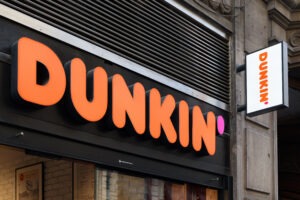The Art and Science of Rebranding
Published on December 4, 2023, 11:46 a.m.
by Katherine Williams and Carsyn Smiling.
On average, there are 4.4 million businesses created each year. This competition drives some companies to “rebrand” in order to stand out to target audiences. However, there are many more factors to consider than meets the eye.
Understanding the brand’s story
Rebranding is an intricate process that requires public relations professionals to look at the foundations of a brand and determine how they can keep their existing narrative and consumer base while also modernizing the brand and targeting new audiences.
“Really, it’s getting to the story of the brand, understanding their background, their mission, their purpose, the services or products that they offer, and using that to create a compelling narrative to hit those target audiences,” Haley Febrey, account executive at KC Projects, stated. “We need to take the narrative that already exists and frame it in a way that’s going to help them hit their new goals.“
Rebranding is a strategic way for brands to respond to change, redefine themselves and reconnect with their audiences in today’s dynamic business landscape.
Twitter’s transformation to X

Companies could rebrand for a plethora of reasons, such as profit margins or even to tailor to a new audience. “Usually, it’s because they want to either go in a new direction — whether it is to change what people think of them — or expand their brand so that they can offer new things,” University of Alabama advertising professor Jay Waters explained.
On July 23, 2023, Twitter officially rebranded to “X” and changed its logo from a blue and white bird to a black background with a prominent white X.
While the Twitter rebrand has definitely changed consumers’ perceptions of the company, whether the rebrand was a good decision lies in limbo for many typical users. Since 2006, Twitter has operated as a public forum, meaning that anyone could create an account and disperse tweets as frequently as they liked for free. With the rebrand to X, many wonder what the future of the public forum will look like.
In October 2023, X started a new test program named “Not A Bot” in both New Zealand and the Philippines that will charge users who want to interact with other accounts a $1 annual subscription. Consumers in those countries are still able to use X and read others’ tweets, but they cannot write their own tweets or interact with others unless they subscribe to the new plan. X’s support team tweeted that this plan was to reduce spam and bot activity, and “it is not a profit driver.”
X’s rebrand changes things for social media and the PR professionals who use it. PR agencies who help manage social media for their clients have to figure out new ways to navigate platforms like X that may charge a subscription fee.
“KC Projects’ involvement on paid social media platforms would be contingent on many factors, including which platforms started charging, our clients’ target audiences and their budget considerations,” offered Anna Catherine Gillespy, account executive. “For clients who have a larger social media following, and gain PR opportunities through those platforms, they would most likely pay to maintain their online presence.”
Dunkin’ rebrand

Febrey mentioned Dunkin’ as an example of a company that has successfully rebranded. In 2018, Dunkin’ Donuts changed its name to “Dunkin’” and kept its original pink and orange colors in the logo.
“Dunkin’ was a very successful rebrand because they wanted to show their audience that they’re more than just your dad’s favorite doughnut shop where he gets his black coffee every day, and they shifted their advertising focus to their specialty coffee drinks, which tapped into a new audience,” Febrey noted.
With competitors like Starbucks and Einstein Bros. gaining ground, Dunkin’ understood the need for action in 2018 to restore its place in the market. Dunkin’ started creating specialty hot and iced drinks to appeal to the younger generation.

Creating a new brand
Large companies often want to expand their brands by catering to both new and current audiences’ needs.
Waters explained that “I worked with Little Debbie, and at one time they sold granola bars. Many people don’t associate Little Debbie with granola bars, so instead they created a new brand Sunbelt Bakery to maintain the Little Debbie brand association that didn’t fit with granola bars.”
Public relations branding teams need to consider all of the possibilities that branching out of their niche and entering new spaces can bring.
Embrace originality
When a company is thinking of undergoing a rebrand, it’s important to give thought to the original brand vision and decide whether to expand or to create a new brand. The rebranding decision depends on a brand’s target audience, its longevity, and the company’s short- and long-term goals. Ultimately, the company should implement brand strategies that embrace the brand’s individuality and stay true the brand’s value.




